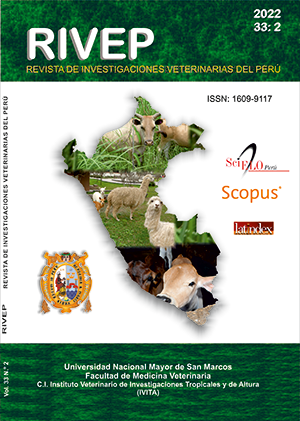Study of the biota of laboratory rats: characterization of commensal Escherichia coli
DOI:
https://doi.org/10.15381/rivep.v33i2.20868Keywords:
E. coli, laboratory animals, microbiotaAbstract
The aim if this study was to characterize strains of E. coli isolated from Rattus norvegicus belonging to a level 1 animal facility. Faecal samples were taken from 13 rats. Five colonies were randomly selected from the primary growth of the culture of each sampled individual. Biochemical tests were performed and the pathotype and phylogroup were established in the strains that were identified as E. coli by means of the PCR technique. In addition, tests for biofilm formation and antimicrobial susceptibility were performed. Results showed that 65% (26/40) of the isolated strains corresponded to E. coli and all clustered in phylogroup B2. Six of the E. coli strains were resistant to nitrofurantoin (23%), four were resistant to ampicillin (15%), and three strains were resistant to cefozolin (11%). None showed the formation of biofilms, nor the amplification of genes related to any pathotype. The results denote that E. coli belonging to the biota of laboratory rats presents resistance to antibiotics and the presence of the chuA and yjaA genes associated with the B2 phylogroup strains related to extraintestinal diseases.
Downloads
Downloads
Published
Issue
Section
License
Copyright (c) 2022 Xochitl Vega-Manriquez, Omar Hernández-Fraga, Juan Manuel Pinos-Rodríguez, Cesar Martínez-Benítez, Ulises Hernández-Chiñas, Carlos Eslava-Campos

This work is licensed under a Creative Commons Attribution 4.0 International License.
AUTHORS RETAIN THEIR RIGHTS:
a. Authors retain their trade mark rights and patent, and also on any process or procedure described in the article.
b. Authors retain their right to share, copy, distribute, perform and publicly communicate their article (eg, to place their article in an institutional repository or publish it in a book), with an acknowledgment of its initial publication in the Revista de Investigaciones Veterinarias del Perú (RIVEP).
c. Authors retain theirs right to make a subsequent publication of their work, to use the article or any part thereof (eg a compilation of his papers, lecture notes, thesis, or a book), always indicating the source of publication (the originator of the work, journal, volume, number and date).










